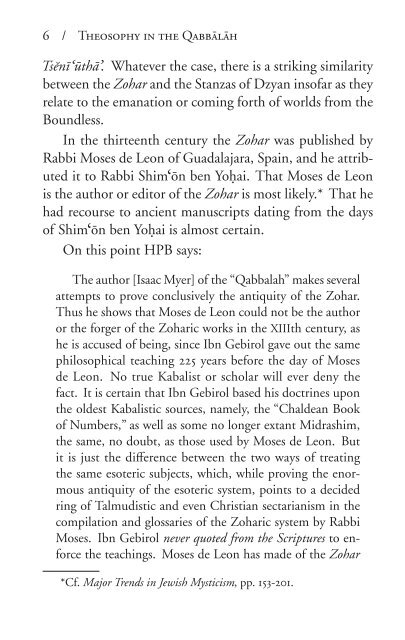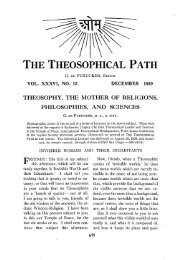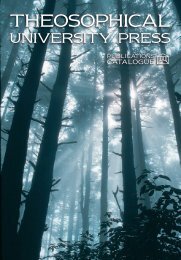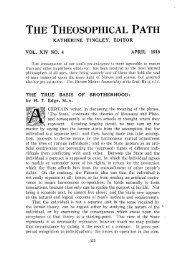Theosophy in the Qabbālāh - The Theosophical Society
Theosophy in the Qabbālāh - The Theosophical Society
Theosophy in the Qabbālāh - The Theosophical Society
Create successful ePaper yourself
Turn your PDF publications into a flip-book with our unique Google optimized e-Paper software.
6 / <strong><strong>The</strong>osophy</strong> <strong>in</strong> <strong>the</strong> Qabbãlãh<br />
Tsênî¡ûthã¿. Whatever <strong>the</strong> case, <strong>the</strong>re is a strik<strong>in</strong>g similarity<br />
between <strong>the</strong> Zohar and <strong>the</strong> Stanzas of Dzyan <strong>in</strong>sofar as <strong>the</strong>y<br />
relate to <strong>the</strong> emanation or com<strong>in</strong>g forth of worlds from <strong>the</strong><br />
Boundless.<br />
In <strong>the</strong> thirteenth century <strong>the</strong> Zohar was published by<br />
Rabbi Moses de Leon of Guadalajara, Spa<strong>in</strong>, and he attributed<br />
it to Rabbi Shim¡õn ben Yo×ai. That Moses de Leon<br />
is <strong>the</strong> author or editor of <strong>the</strong> Zohar is most likely.* That he<br />
had recourse to ancient manuscripts dat<strong>in</strong>g from <strong>the</strong> days<br />
of Shim¡õn ben Yo×ai is almost certa<strong>in</strong>.<br />
On this po<strong>in</strong>t HPB says:<br />
<strong>The</strong> author [Isaac Myer] of <strong>the</strong> “Qabbalah” makes several<br />
attempts to prove conclusively <strong>the</strong> antiquity of <strong>the</strong> Zohar.<br />
Thus he shows that Moses de Leon could not be <strong>the</strong> author<br />
or <strong>the</strong> forger of <strong>the</strong> Zoharic works <strong>in</strong> <strong>the</strong> XIIIth century, as<br />
he is accused of be<strong>in</strong>g, s<strong>in</strong>ce Ibn Gebirol gave out <strong>the</strong> same<br />
philosophical teach<strong>in</strong>g 225 years before <strong>the</strong> day of Moses<br />
de Leon. No true Kabalist or scholar will ever deny <strong>the</strong><br />
fact. It is certa<strong>in</strong> that Ibn Gebirol based his doctr<strong>in</strong>es upon<br />
<strong>the</strong> oldest Kabalistic sources, namely, <strong>the</strong> “Chaldean Book<br />
of Numbers,” as well as some no longer extant Midrashim,<br />
<strong>the</strong> same, no doubt, as those used by Moses de Leon. But<br />
it is just <strong>the</strong> difference between <strong>the</strong> two ways of treat<strong>in</strong>g<br />
<strong>the</strong> same esoteric subjects, which, while prov<strong>in</strong>g <strong>the</strong> enormous<br />
antiquity of <strong>the</strong> esoteric system, po<strong>in</strong>ts to a decided<br />
r<strong>in</strong>g of Talmudistic and even Christian sectarianism <strong>in</strong> <strong>the</strong><br />
compilation and glossaries of <strong>the</strong> Zoharic system by Rabbi<br />
Moses. Ibn Gebirol never quoted from <strong>the</strong> Scriptures to enforce<br />
<strong>the</strong> teach<strong>in</strong>gs. Moses de Leon has made of <strong>the</strong> Zohar<br />
*Cf. Major Trends <strong>in</strong> Jewish Mysticism, pp. 153-201.













